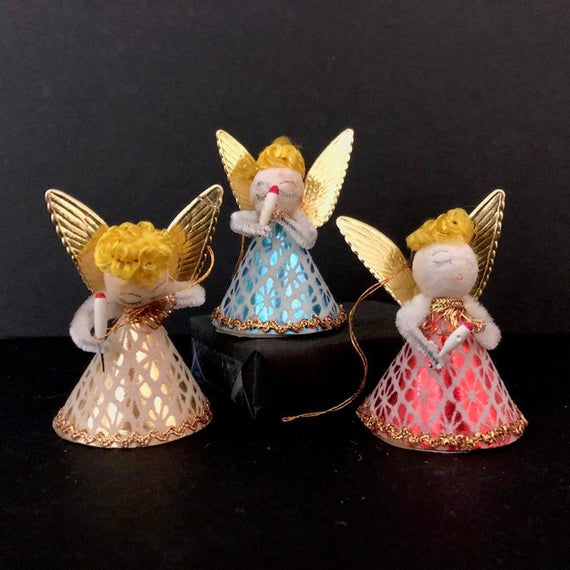|
A meditation on the Annunciation, Luke 1:26-38, for the community of St. David of Wales Episcopal Church on the Fourth Sunday of Advent.
Growing up, my family had a set of paper angel ornaments that we put on our Christmas tree each year. They stood about two inches high with yellow curls stapled to their paper heads and gold paper wings stapled to their backs. Some held guitars, some autoharps like my teachers played, but my favorite were the singing angels who held white microphones with red tips right in front of their chests with pipe cleaner hands. I made it my job to unpack the angels, and the year my parents divorced, while I waited for my mom to come home from work so we could decorate the tree, I placed the singing angels on risers made of the empty ornament boxes, separating the altos from the first and second sopranos, and sang for them, a one-girl choir belting out every Christmas carol I knew. And I knew quite a few, having memorized many popular carols to the fourth verse. The December I was 21 and newly married, my mother gave a third of her ornaments to my sister, and another third to me. When we sorted the faded paper angels, my mother said the instrumentalists were playing mandolins and harps. I hadn’t guessed the instruments quite right, and that was okay, but when we came to the microphone angels, both my mother and my sister laughed and insisted the angels were holding candles, pointing to red tips they said were obviously flames. As soon as they said it, I saw how wrong I’d been all those years. I was a bit disappointed when I hung mute angels from my tree, but I sang the carols for them anyway. The songs touched something hidden deep within me, something I would later understand as the life of the soul. At that point in my life, I was curious about God but cautious. I didn’t want to get too close or personal. I wanted my angels to carry microphones, to fly around the neighborhood, sing out good news, and give me direction from a nice safe distance that didn’t require any action on my part. But as the years went by, and God came closer into my life, my thoughts about those candle carrying angels changed. I no longer saw them as mute and boring. I’ve always been afraid of fire. I never liked to light matches to start pilot lights or campfires, and I realized that to become a candle-holding angel, you have to strike a match and lean in close to the flame, you have to stay with the fire, hold steady, and act with care. You have to be brave and intentional in an act that’s ordinary and unglamorous. And in doing so, you help others to see. And so I’m thankful for the appearance of angels this Advent, this season of casting light into the darkness, this time of anticipation, of looking forward to a birth that’s come, and comes again, anew. And in today’s Gospel reading, we have the arrival of the angel Gabriel. He arrives without instruments, microphones, or candles, but his message cannot be ignored, even if it is not easily understood. “How can this be?” Mary asks as she considers what it means to find favor with God. I’m amazed that Mary has the presence of mind to speak up and ask questions. Impressed that she didn't run screaming, or cower under the bed. My fight, flight, or freeze response would’ve been firing away. But Mary takes it all in. Here comes an angel — cause enough for fear and trembling on his own — and then he offers an announcement to a small town teenage girl that God is going to break into human history through her, not some powerful king or ruler. An ordinary, yet extraordinary, young woman will carry and deliver God’s child. Can’t you just hear my paper angels dropping their microphones at the news? Two thousand and some years later, our jaws no longer drop at the absurdity, we’re so used to this story. Over the centuries, we’ve immortalized it in scripture, and art and music, in the carols I liked to belt out along with my angel ornaments. We’ve tamed it with familiarity, painting Mary as meek, mild, everything as peaceful and orderly as a Thomas Kincaid painting. But when we peel back our familiarity, and the comfort we have in knowing the history of these events, the whole idea seems preposterous. It’s crazy that the Creator of the Universe would plan to redeem creation by sending a baby to a poor and vulnerable young woman and her fiancé, an ethnic and religious minority couple living under occupation of an empire, forced to travel for a census and taxation. A couple who will soon become homeless refugees, forced to give birth in a stall with animals, and then hide out in another country while an army combs the countryside killing any baby that might possibly be Mary’s. Though she had no idea about any of this when Gabriel appears to her, we can feel the weight of Mary’s yes. The gravity of her consent. The courage in her words: “Here am I, the servant of the Lord; let it be with me according to your word.” Who among us would say yes with such conviction? My tendency, if I didn’t say, “No thank you,” immediately, would be to say, “Can I get back to you? I need some time to think about this.” I would try to be logical, making a pro and con sheet loaded with facts, driven by logic. And it’s doubtful my calculations would lead to a yes. Those lists never seem to lead to risking a “yes.” They keep us in “no.” Thankfully, faith isn’t logical. As the author of the Letter to the Hebrews reminds us, “faith is the assurance of things hoped for, the conviction of things not seen.” Mary is our model of that deep faith. Her journey affirms what we already now: love always involves risk and suffering. This year, the darkness of the season at our latitude has been magnified by the shadow of pandemic disease as we stay separated physically from one another, forgoing our usual holiday festivities. We hope for things unseen. The time when we can visit our families; a vaccine to curb the pandemic; healthy people, a healthy planet, and robust economies. Now, more than ever, we need to take heart and hope from Mary’s words and actions, from her wondering how this can be, and her boldness in saying yes to what she doesn’t yet understand. As we wonder what comes next, as we ask, “how can this be?” as we live day by day with more questions than answers, may we find hope in the visitation of angels, in the messages flickering in their candlelight, and booming from their microphones. May we listen to assure us not to be afraid. May we ponder the miracle of Christ’s advent, his arrival, again and again, into a broken and weary world need of healing. And let us remember the promise of the Angel Gabriel: Nothing is impossible with God.
0 Comments
Your comment will be posted after it is approved.
Leave a Reply. |
I began blogging about "This or Something Better" in 2011 when my husband and I were discerning what came next in our lives, which turned out to be relocating to Puget Sound from our Native California. My older posts can be found here.
Categories
All
Archives
September 2023
Newsletters |

